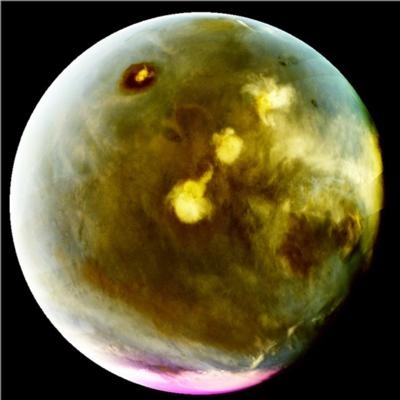Shows Martian Atmosphere In 'Unprecedented Detail'
New global images of Mars from the MAVEN mission show the ultraviolet glow from the Martian atmosphere in unprecedented detail, revealing dynamic, previously invisible behavior. They include the first images of "nightglow" that can be used to show how winds circulate at high altitudes. Additionally, dayside ultraviolet imagery from the spacecraft shows how ozone amounts change over the seasons and how afternoon clouds form over giant Martian volcanoes. The images were taken by the Imaging UltraViolet Spectrograph (IUVS) on the Mars Atmosphere and Volatile Evolution mission (MAVEN).

"MAVEN obtained hundreds of such images in recent months, giving some of the best high-resolution ultraviolet coverage of Mars ever obtained," said Nick Schneider of the Laboratory for Atmospheric and Space Physics at the University of Colorado, Boulder. Schneider is presenting these results Oct. 19 at the American Astronomical Society Division for Planetary Sciences meeting in Pasadena, California, which is being held jointly with the European Planetary Science Congress.
Nightside images show ultraviolet (UV) "nightglow" emission from nitric oxide (abbreviated NO). Nightglow is a common planetary phenomenon in which the sky faintly glows even in the complete absence of external light. Mars' nightside atmosphere emits light in the ultraviolet due to chemical reactions that start on Mars' dayside. Ultraviolet light from the sun breaks down molecules of carbon dioxide and nitrogen, and the resulting atoms are carried around the planet by high-altitude wind patterns that encircle the planet. On the nightside, these winds bring the atoms down to lower altitudes where nitrogen and oxygen atoms collide to form nitric oxide molecules. The recombination releases extra energy, which comes out as ultraviolet light.
Scientists predicted NO nightglow at Mars, and prior missions detected its presence, but MAVEN has returned the first images of this phenomenon in the Martian atmosphere. Splotches and streaks appearing in these images occur where NO recombination is enhanced by winds. Such concentrations are clear evidence of strong irregularities in Mars' high altitude winds and circulation patterns. These winds control how Mars' atmosphere responds to its very strong seasonal cycles. These first images will lead to an improved determination of the circulation patterns that control the behavior of the atmosphere from approximately 37 to 62 miles (about 60 to 100 kilometers) high.
Dayside images show the atmosphere and surface near Mars' south pole in unprecedented ultraviolet detail. They were obtained as spring comes to the southern hemisphere. Ozone is destroyed when water vapor is present, so ozone accumulates in the winter polar region where the water vapor has frozen out of the atmosphere. The images show ozone lasting into spring, indicating that global winds are inhibiting the spread of water vapor from the rest of the planet into winter polar regions. Wave patterns in the images, revealed by UV absorption from ozone concentrations, are critical to understanding the wind patterns, giving scientists an additional means to study the chemistry and global circulation of the atmosphere.
MAVEN observations also show afternoon cloud formation over the four giant volcanoes on Mars, much as clouds form over mountain ranges on Earth. IUVS images of cloud formation are among the best ever taken showing the development of clouds throughout the day. Clouds are a key to understanding a planet's energy balance and water vapor inventory, so these observations will be valuable in understanding the daily and seasonal behavior of the atmosphere.
"MAVEN's elliptical orbit is just right," said Justin Deighan of the University of Colorado, Boulder, who led the observations. "It rises high enough to take a global picture, but still orbits fast enough to get multiple views as Mars rotates over the course of a day."
MAVEN's principal investigator is based at the University of Colorado's Laboratory for Atmospheric and Space Physics, Boulder. The university provided two science instruments and leads science operations, as well as education and public outreach, for the mission. NASA's Goddard Space Flight Center in Greenbelt, Maryland, manages the MAVEN project and provided two science instruments for the mission. The University of California at Berkeley's Space Sciences Laboratory also provided four science instruments for the mission. Lockheed Martin built the spacecraft and is responsible for mission operations. NASA's Jet Propulsion Laboratory in Pasadena, California, provides navigation and Deep Space Network support, as well as the Electra telecommunications relay hardware and operations.
(Images provided with NASA news release)
 OSH25 Day Four Redux: Spirit SE-1!, H55 eFlyer, King Schools
OSH25 Day Four Redux: Spirit SE-1!, H55 eFlyer, King Schools ANN Thanks Our Speedy Sponsor... Blackshape!!!
ANN Thanks Our Speedy Sponsor... Blackshape!!! Alpha Systems AOA Guides ANN Oshkosh Coverage
Alpha Systems AOA Guides ANN Oshkosh Coverage Pilot Mall Intro's High Flying Models To ANN Sponsor Lineup
Pilot Mall Intro's High Flying Models To ANN Sponsor Lineup CiES Fuels ANN's Oshkosh 2025 Special Event Coverage
CiES Fuels ANN's Oshkosh 2025 Special Event Coverage



